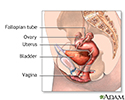Genital injury
Scrotal trauma; Straddle injury; Toilet seat injury
A genital injury is an injury to male or female sex organs, mainly those outside the body. It also refers to injury in the area between the legs, called the perineum.
Considerations
Injury to the genitals can be very painful. It may cause a lot of bleeding. Such injury can affect the reproductive organs and the bladder and urethra.
Damage may be temporary or permanent.
Causes
Genital injury can occur in both women and young girls. It may be caused by placing items into the vagina. Young girls (most often less than 4 years of age) may do this during normal exploration of the body. Objects used may include toilet tissue, crayons, beads, pins, or buttons.
It is important to rule out sexual abuse, rape, and assault. The health care provider should ask the girl how the object was placed there.
In men and young boys, common causes of genital injury include:
- Having the toilet seat fall down onto the area
- Getting the area caught in a pant zipper
- Straddle injury: falling and landing with the legs on each side of a bar, such as a monkey bar or the middle of a bicycle
Symptoms
Symptoms may include:
- Abdominal pain
- Bleeding
- Bruising
- Change in shape of the affected area
- Faintness
- Foul-smelling vaginal or urethral discharge
- Object embedded in a body opening
- Groin pain or genital pain (can be extreme)
- Swelling
- Urine drainage
- Vomiting
- Urination that is painful or the inability to urinate
- Open wound
First Aid
Keep the person calm. Be sensitive to privacy. Cover the injured area while giving first aid.
Control bleeding by using direct pressure. Place a clean cloth or sterile dressing on any open wounds. If the vagina is bleeding severely, put sterile gauze or clean cloths on the area, unless a foreign body is suspected.
Apply cold compresses to help reduce swelling.
If the testicles have been injured, support them with a sling made from towels. Place them on a padded cloth, such as a diaper.
If there is an object stuck in a body opening or wound, leave it alone and seek medical attention. Taking it out may cause more damage.
Do Not
DO NOT try to remove an object by yourself. Seek medical help right away.
Never volunteer your thoughts on how you think the injury happened. If you think the injury was the result of assault or abuse, DO NOT let the person change clothes or take a bath or shower. Seek medical help right away.
When to Contact a Medical Professional
A straddle injury is damage to the testicle or urinary tract. Get medical help right away if there is:
- A lot of swelling or bruising
- Blood in the urine
- Difficulty urinating
Seek medical help right away if there is a genital injury and:
- Pain, bleeding, or swelling
- A concern about sexual abuse
- Problems urinating
- Blood in the urine
- Open wound
- Large amount of swelling or bruising of the genitals or surrounding areas
Prevention
Teach safety to young children and create a safe environment for them. Also, keep small objects out of the reach of toddlers.
References
Faris A, Yi Y. Trauma to the genitourinary tract. In: Kellerman RD, Rakel DP, Heidelbaugh JJ, Lee EM, eds. Conn's Current Therapy 2023. Philadelphia, PA: Elsevier: 2023;1169-1172.
Lang SC, Shewakramani SN. Genitourinary trauma. In: Walls RM, ed. Rosen's Emergency Medicine: Concepts and Clinical Practice. 10th ed. Philadelphia, PA: Elsevier; 2023:chap 39.
Taylor JM, Smith TG, Coburn M. Urologic surgery. In: Townsend CM Jr, Beauchamp RD, Evers BM, Mattox KL, eds. Sabiston Textbook of Surgery. 21st ed. St Louis, MO: Elsevier; 2022:chap 74.
Review Date: 10/15/2022









